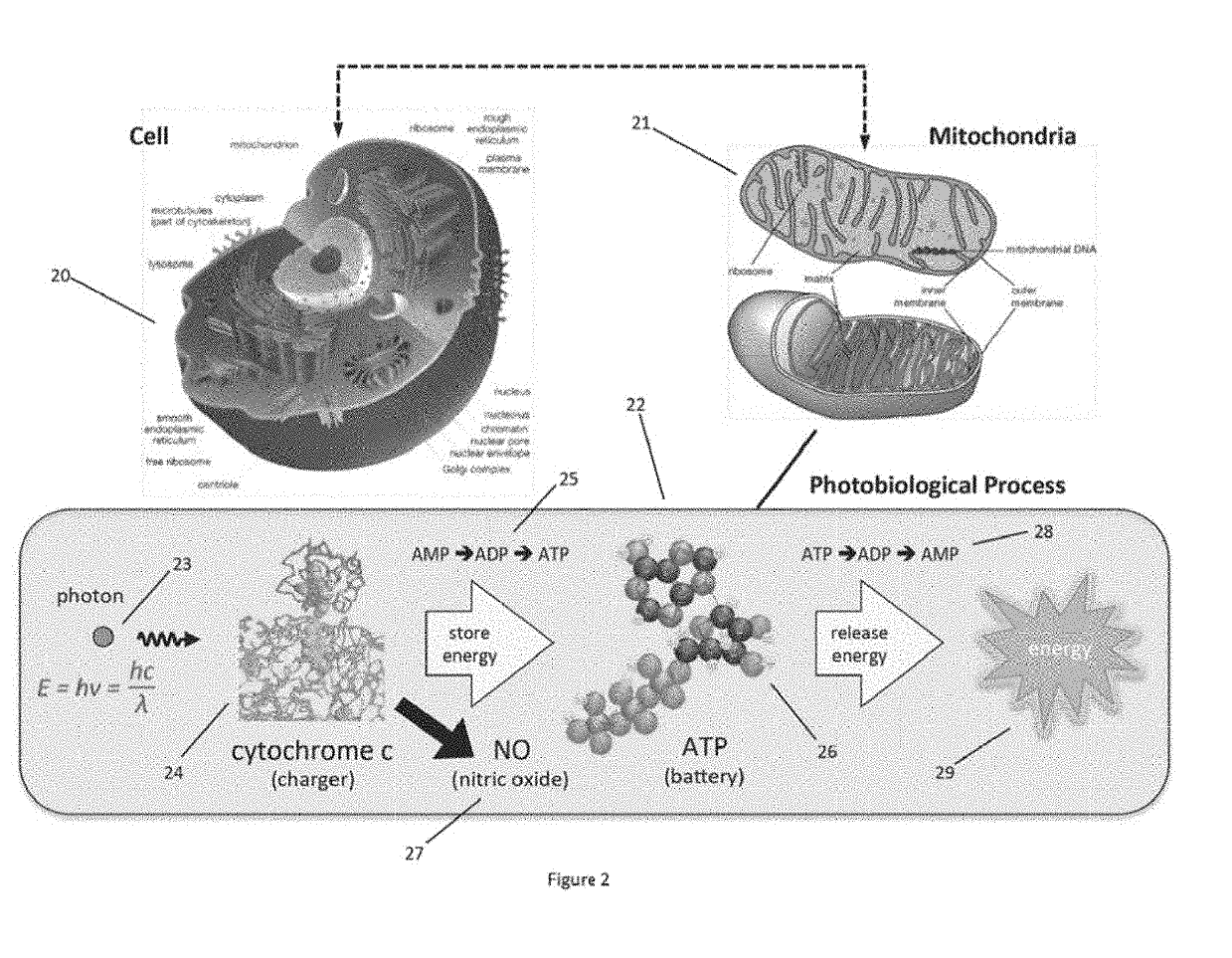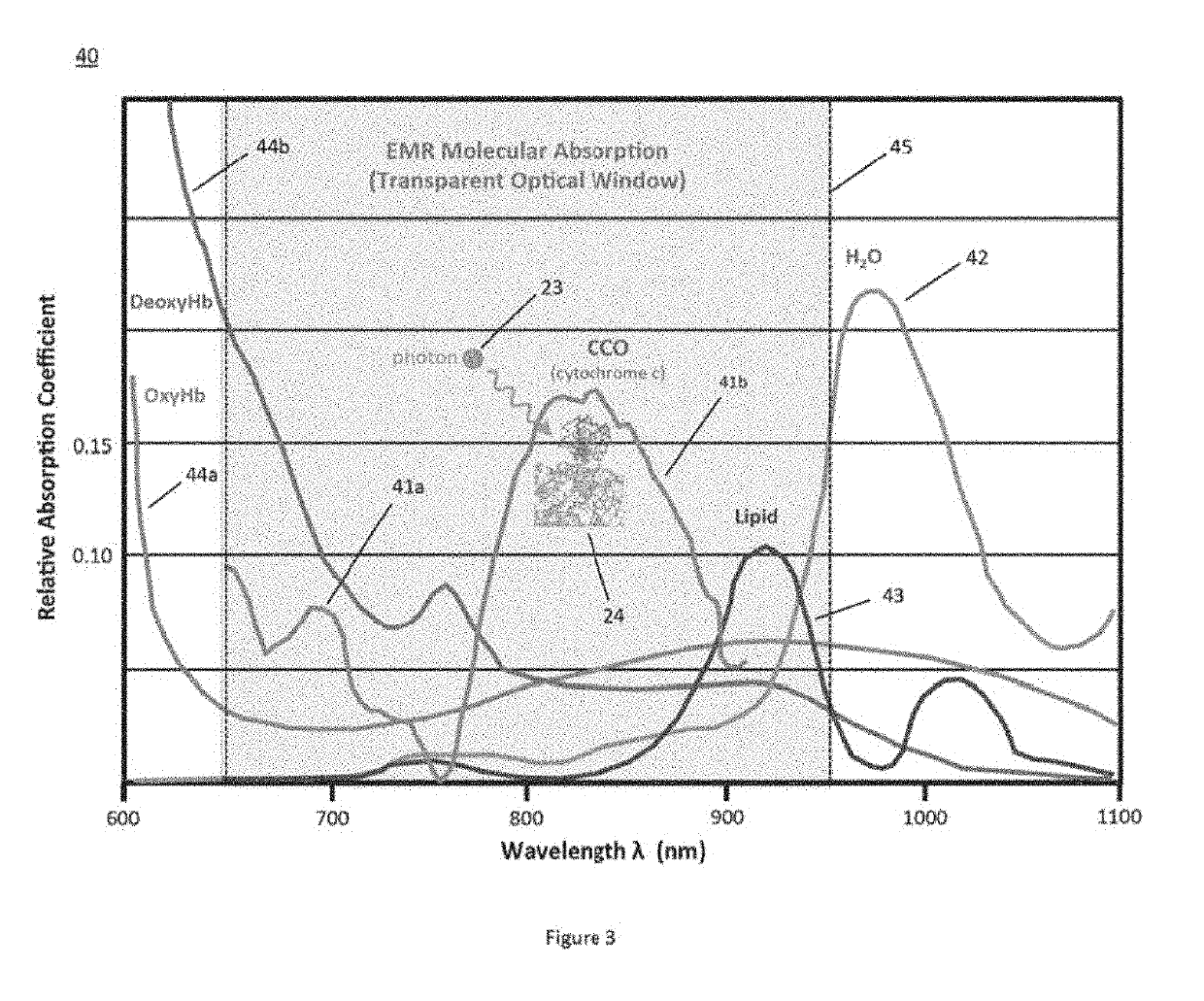While early attempts used filtered lamps, lamps are extremely hot and uncomfortable for patients, potentially can burn patient and doctors, and are extremely difficult in maintaining uniform illumination during a treatment of extended durations.
Lamps also suffer short lifetimes, and if constructed using rarified gasses, can also be expensive to replace regularly.
Unfiltered lamps, like the sun, actually deliver too broad of a spectrum and limit the
efficacy of the photons by simultaneously stimulating both beneficial and unwanted chemical reactions, some involving harmful rays, especially in the
ultraviolet portion of the
electromagnetic spectrum.
Like lamps, lasers risk burning a patient, not through heat, by exposing tissue to intense concentrated
optical power.
A second, more practical problem arises from a
laser's small “spot size”, the illuminated area.
Because a
laser illuminates a small focused area, it is difficult to treat large organs, muscles, or tissue and it is much easier for an overpower condition to arise.
Another problem with
laser light results from its “coherence,” the property of light preventing it from spreading out, making it more difficult to cover large areas during treatment.
Moreover, the optical spectrum of a laser is too narrow to fully excite all the beneficial chemical and molecular transitions needed for to achieve high
efficacy PBT.
The limited spectrum of a laser, typically a range of ±1 nm around the laser's center
wavelength value, makes it difficult to properly excite all the beneficial chemical reactions needed in PBT.
It is difficult to cover a range of frequencies with a
narrow bandwidth optical source.
So whiles
sunlight exhibits an excessively
broad spectrum, photobiologically exciting many competing chemical reactions with many EMR wavelengths, some even harmful,
laser light is too narrow and does not stimulate enough chemical reactions to reach full
efficacy in phototherapeutic treatment.
Another
disadvantage of broad-spectrum PBT is that light wavelengths that do not invoke any beneficial photobiological effect are none-the-less absorbed and elevate the temperature of tissue under treatment.
In essence the maximum energy budget is wasted by useless light wavelengths.
This range is simply too wide for lasers to cover in a practical manner.
The result is poor uniformity in LED brightness across a LED pad, from LED pad to LED pad, and from one manufacturing batch to the next.
These signals are sensitive to
common mode noise and ground loops affecting the magnitude and duration of the pulses controlling LED operation.
As simple electrical pulses, the system also lacks any
error checking capability so malfunctions cannot be corrected or even detected.Unidirectional
signal flow from PBT controller to LED pad—With unidirectional data flow, PBT controllers cannot authenticate any LED pad connected to its output, nor once connected can they monitor a pad's operating condition.
This misconnection error can damage the
LED driver circuitry, cause LED overheating, patient burn risk, and potentially fire.Inability to identify approved LED pads or certified manufacturers—Lacking any ability to identify a LED pad's pedigree a PBT system will unknowingly drive any LED connected to it including illegal, counterfeit, or knock-off LED pads.
Driving pads not made or certified by the system specifier or manufacturer has unknown consequences
ranging from loss of functionality and reduced efficacy to safety risks.
Commercially, the merchandizing and sale of counterfeit and copycat LED pads also robs IP licensed PBT device merchants of legal income.Inability to identify a
connected device is a LED pad—Without the ability to confirm if a device connected to a PBT controller output is a LED pad (rather than a completely unrelated
peripheral such as a speaker, battery, motor, etc.), connection of an unauthorized
electrical load to a PBT system's output will invariably damage either the accessory, the PBT controller, or both.
When driving an unknown
electrical load,
high voltage present on the controller's output pins during operation also presents a
fire hazard.Inability to identify power sources—The inability of a PBT controller to identify connection of its output to a power source (such as
AC power adapters, batteries, car electrical power, or generators) represents a real
safety risk, whereby the power supply contained within the PBT controller competes with the external power source.
The
interconnection of two dissimilar power supplies may result in excessive currents, voltages, power dissipation, or uncontrolled oscillations leading to damage of the external power source, the PBT controller, or both.Inability to control or limit driver output current—Connection of a shorted load such as a damaged pad, a wire short, or any load that exhibits an high
inrush current (such as a motor) represents a
high current risk and possibly a
fire hazard.
Inductive loads such as solenoids also can momentarily create excessive voltages damaging low-
voltage components.Inability to detect batteries connected to a PBT system's output—Connecting a
battery pack to a PBT system's output has the potential for damaging the
battery pack, accidentally charging the battery with the wrong charging conditions and giving rise to over-
voltage, over-current, or over-temperature conditions in the electrochemical cells.
Improper charging of wet-
chemistry or acid batteries has the potential for acid or
electrolyte leaks.
The improper charging of
lithium ion batteries can cause overheating, fire, and even explosions.Inability to detect over-temperature conditions in LED pads—Overheating of a LED pad risks patient discomfort and burns, pad damage, and in extreme cases the possibility of fire.Inability to identify the LED configuration within a LED pad—Unable to identify the series-
parallel array configuration of LEDs in a LED pad, the PBT controller is unable to determine if the pad is compatible with the PBT system or even if LED operation is possible.
For example, too few series connected LEDs can damage the LEDs with too much
voltage.
Too many series connected LEDs will result in dim or no illumination.
Too many parallel strings of LEDs can result in excessive total pad current and consequentially overheating, as well as large voltage drops across interconnections, poor light uniformity across a LED pad, and possible damage to PCB's conductive traces.Inability to identify the types of LEDs contained within a LED pad—Unable to detect what
wavelength LEDs are in a pad, a PBT system has no means by which to match its treatment programs to the
LED array or to select the right
wavelength LEDs for each specific waveform in the
treatment protocol.PBT controller outputs are each limited to a fixed number of control signals—With only one or two control signals per output, today's PBT controllers are incapable of driving three, four, or more different wavelengths of LEDs within the same pad with different excitation patterns.
Limited mobility—In
present day medical grade PBT systems, the connection of a central PBT controller to LED pads requires cable connections.
While such tethered PBT systems are generally acceptable in hospital applications (and possibly in
clinical settings), in
consumer, paramedic, and military applications limiting mobility with cables or wires is not useful.Incapable of waveform synthesis—PBT systems lack the technology to drive LEDs with any waveforms other than
square wave pulses.
Since
pulse frequency affects the
energy coupling to specific tissue types, a single frequency PBT system can only optimally treat once
tissue type at a time, extending the required therapy time and patient / insurance cost.
Analysis also reveals
square wave pulses waste energy producing off
harmonics not necessarily beneficial to a therapy.
Although host PBT controllers should have sufficient compute capability to synthesize such waveforms, the capability is not beneficial because the
signal cannot be delivered over long cables without suffering significant
waveform distortion.
Unfortunately, LED pads cannot perform the task.
Using cheap discrete components,
present day LED pads are incapable of performing any waveform synthesis whatsoever, not to mention the communication protocols needed to remotely select or change the synthesized waveform do not exist.Distribution of new
LED driver algorithms—Present PBT systems lack the ability to download
software updates from a
database or
server to correct
software bugs or to install new treatment algorithms.Inability to capture and
record real time patient
biometric data—Present PBT systems lack the ability to collect
biometric data such as
brain waves,
blood pressure,
blood sugar, blood
oxygen, and other
biometrics during a treatment or the ability to embed this collected data into the treatment
file record or to
append biometric data into a treatment file using a common time base as a reference.Inability to gather real time images of treatment area—Present PBT systems lack any means by which to measure or create images of tissue during treatment.
The systems also lack the ability to store still and video images or to match the images to a PBT session's
treatment time.Inability for users (doctors) to create new treatment algorithms—Present PBT systems lack any capability for users such as physicians or researchers to create new algorithms or to string existing treatments together to form complex therapy specific treatments, e.g. optimizing an excitation sequence for activating injected stem cells (useful in accelerating
stem cell differentiation while reducing rejection risks.
)Electronic distribution of
documentation—Present PBT systems are unable to distribute and update any
documentation electronically.
Such capability is not available in any medical devices today.Treatment tracking—Present PBT systems are unable to track the
treatment use history, capture the system's use in a treatment log, and upload the treatment log to a
server.
Lacking real time treatment logs via
network connectivity, the widespread commercial adoption of PBT systems by physicians, hospitals, clinics, and spas is problematic.
Without uploaded use logs,
present day PBT systems cannot support revenue-sharing lease business models because the leaser is unable to verify the leasee'
s system use.
Similarly hospitals and clinics cannot confirm PBT systems use for insurance audits and for fraud prevention.
In pay-to-use SaaS (
software as a service)
payment models, the PBT service agent is unable to confirm a
client's use history.
Electronic prescriptions—No physical
medicine devices today including PBT systems are capable of securely transferring and distributing doctor prescriptions into a
medical device.Remote disable—No PBT system today is capable of disabling device operation in the case of non-
payment or in the case of theft to stop black market trade.
Location tracking—No PBT system today is capable of tracing the location of a stolen PBT system to track the thieves.
Secure communication—Since PBT systems today use electrical signals rather than packet based communication to control LED pads, then hacking and direct measurement of communication between a host PBT system and a LED pad is trivial, lacking any security whatsoever.
In the future,
encryption alone is expected to be inadequate in securing data communication across
the Internet.
One of the biggest limitations of PBT systems is their
network connectivity or more specifically their lack thereof.
Because PBT is biphasic, meaning too little or too much photonic
radiation can reduce
treatment efficacy, accidental over-
dose can result in
dehydration and reduction in a treatment's therapeutic value, discouraging a patient from continuing treatment.
Without proper safeguards, a network failure could also allow a large or
rapid rise in pad temperature with the potential for burn risk.
Moreover, lacking proper
network security safeguards, a network connected PBT device can be hacked and hijacked, allowing a cybercriminal to take control of a person's therapy for mischievous or even nefarious purposes.
Information extracted from a system could reveal a person's identity (
identity theft risk), their medical treatments (insurance fraud risk), and even their medical conditions (blackmail risks).
Lacking the provisions to overcome these safety and security vulnerabilities, today's medical devices are totally incapable of insuring a level of quality, reliability, and security needed to guarantee IoMT operation.
In summary, present-day PBT systems comprising a controller unit driving passive LED pads are limited both in their therapeutic and diagnostic capability.
Such limitations include an inability to deliver
distortion-free waveform synthesis in LED drive, an inability of extracting real time biometric data and images, and lacking the capability for the system or device to communicate over a wired or
wireless network with computer servers, data storage devices and clouds, or with doctors and caregivers.
 Login to View More
Login to View More  Login to View More
Login to View More 


